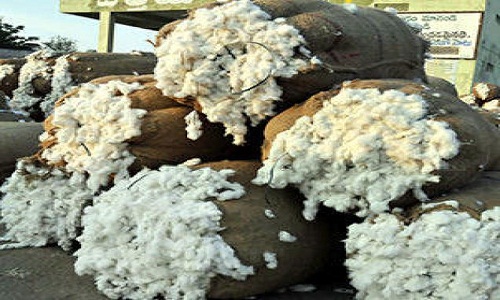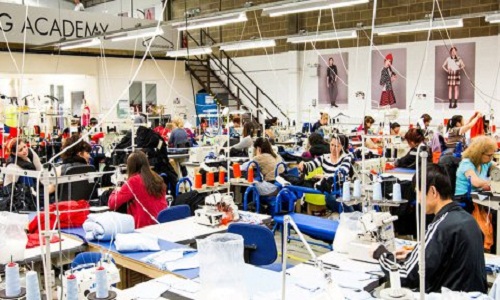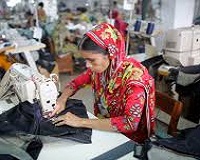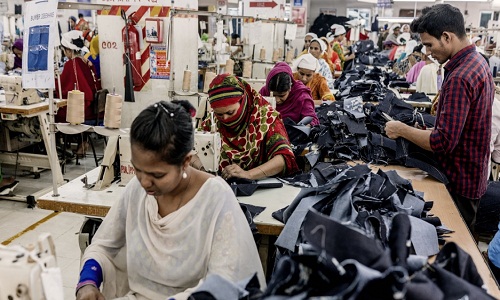FW
The Vietnam textile industry which saw export value grow 15 per cent per year in five years from 2010 to 2015 is expected to reach $29 billion this year in terms of export value. While the target in export value was much lower than the figures in reality, the development plan was not suitable with the real development of the industry. Though the textile and garment industry was slated to reach $20 billion in export value in 2015 but the industry has reached an export value of $27.5 billion.
The Vietnam Textile and Apparel Association asked the government and sectors to review its development plan for the garment industry by 2020 in order to support local textile and garment enterprises to take opportunities as well as overcome challenges from free trade agreements.
The Association has said there should be renovation of the development plan for the textile and garment industry by 2020 and towards 2030. This is necessary because the industry expects to enjoy many advantages in development over the next 10 years. The adjustment of the plan should be effective until 2025, and towards 2040.
The association has also suggested building development plans for the industry including industrial zones. Many small textile and garment firms have not been put up in specialized zones for the textile and garment sector that led to difficulties in the management and treatment of waste water. This is related to the industry’s sustainable development and protection of the environment.
"To ensure supplies to the Indian textiles industry, the Cotton Corporation of India (CCI) has resorted to commercial purchase of cotton at market rates from around the country. CCI has issued notices reaching out to buyers informing them that they will shortly commence e-auction of FP bales for the cotton season 2016-17. Buyers who are not yet registered may register themselves with the for participating in e-auction of FP bales."

To ensure supplies to the Indian textiles industry, the Cotton Corporation of India (CCI) has resorted to commercial purchase of cotton at market rates from around the country. CCI has issued notices reaching out to buyers informing them that they will shortly commence e-auction of FP bales for the cotton season 2016-17.
Buyers who are not yet registered may register themselves with the for participating in e-auction of FP bales. M M Chockalingam, CMD (in-charge) said that after a gap of almost four years, the Corporation has made a small beginning and purchased about 1,000 bales of 170 kg each so far at commercial rates from various centres even as cotton trades firm on lower arrivals due to the impact of the currency crunch.

The CCI expects to purchase around 15 lakh bales for the season of 2016-17. The prices of the commodity are ruling between Rs 5 000 and Rs. 5,200 per quintal in various markets while Minimum Support Price (MSP) is at Rs 4,160 per quintal and therefore procurement at MSP seems unlikely, he added.
However, apart from MSP operations, CCI also has to perform commercial operations at times in the interests of the farmers and to keep the market stable. CCI has been purchasing kapas or raw cotton from markets wherever the prices are lower. The commercial purchase of up to 15 lakh bales would be mainly from the West, Central and Southern parts of the country as prices in the Northern markets are being quoted at a higher price. Kapas prices are ruling between R5, 000 to R5, 200 per quintal in various markets. While prices are expected to soften a bit from next month, most experts have ruled out a drastic fall.
Sutlej is one of the largest integrated textile manufacturing companies and is strongly positioned in the production of value added synthetic, natural and blended yarns, spun yarns, processing of fabrics and home textiles. Sutlej has a strong global clientele and exports to more than 60 countries. It exports to: Australia, Argentina, Bangladesh, Bahrain, Belgium, Brazil, Canada, China, Chile, Cuba, Egypt and France. For fiscal 2016 and the half year ended September 30, 2016, total export revenue as a percentage of total revenue was about 26 per cent. The home textile segments contribution of exports to total revenues is more than 35 per cent.
The company will continue to upgrade existing facilities by adding, modernising existing machinery and installing additional latest technology machines across segments. After witnessing sluggish growth during 2008, the home textile segment has shown signs of recovery and registered considerable growth in the last few years. The home textile segment is growing at a CAGR of 3.5 per cent. The US and EU are gradually coming out of the recessionary phase. Apparel and home textile consumption is picking up. Going forward India's share is expected to rise from seven to ten per cent.
To arrest the widening trade deficit as substantial capacity to produce exportable surplus is either fully or partially closed due to high energy cost and other factors, the Pakistan Textile Exporters Association (PTEA) has asked for immediate announcement of textile package as promised by the prime minister earlier.
Talking about export figures, PTEA chairman Ajmal Farooq and vice chairman Muhammad Naeem expressed concern over widening trade deficit and shrinking exports. Quoting figures, they said the country's exports plunged 3.93 per cent to $8.18 billion during July-November this year, which was $334.68 million less than the comparative period of previous year. Compared to this, the import bill increased 8.7 per cent to almost $20 billion in the same period. In absolute terms, the import bill was $1.6 billion more than that in the last year.
They termed high cost of production and un-competitiveness as major hurdles in export growth. They further maintained that if the reasons behind the industrial crisis were not addressed, situation might get alarming further in the coming months while a drop in exports would have dire impact on economy which is already under pressure.
US researchers have created a novel material out of silk protein that can be preprogrammed with biological, chemical, or optical functions, such as mechanical components that change color with strain, deliver drugs, or respond to light. Using a water-based fabrication method based on protein self-assembly, the researchers generated three-dimensional bulk materials out of silk fibroin, the protein that gives silk its durability.
They manipulated the bulk materials with water-soluble molecules to create multiple solid forms, from the nano- to the micro-scale that have embedded, pre-designed functions. Researchers created a surgical pin that changes color as it nears its mechanical limits and is about to fail, functional screws that can be heated on demand in response to infrared light, and a biocompatible component that enables the sustained release of bioactive agents, such as enzymes.
The ability to embed functional elements in biopolymers, control their self-assembly, and modify their ultimate form creates significant opportunities for bio-inspired fabrication of high-performing multifunctional materials. Silk's unique crystalline structure makes it one of nature's toughest materials. Fibroin, an insoluble protein found in silk, has a remarkable ability to protect other materials while being fully biocompatible and biodegradable. The mechanical toughness of silk fibers is probably caused by embedded crystalline units acting as cross links of silk proteins in the fiber.
Bangladesh is set to become the largest importer of cotton from India. Over the past two years, cotton trade between the two neighbors has increased. In March 2016 a whopping 49 per cent of Bangladesh’s cotton imports were from India. Bangladesh’s booming readymade garment industry has seen a constant rise in demand for cotton fabric.
On the other hand global giants like the US and China have shifted their cotton imports away from India. China’s falling demand for Indian cotton can be attributed to a discernible shift from labor-intensive industries due to fluctuating prices. At the end of the 2014-2015 fiscal year, the net import value of cotton in Bangladesh was 8.8 per cent of global imports and the second highest globally. India was the second highest exporter of cotton globally, valued at 13.8 per cent of global exports. In the 2015-2016 fiscal year, Bangladesh was also the largest cotton importer in the world, with an approximately 18 per cent market share.
Bangladesh is poised to become a regional garment hub because of low costs, availability of semi-skilled manpower, flexible labor regulations, and most importantly duty-free access to lucrative markets such as Europe and the US due to its status as a least-developed country.
"Even if all goes as planned and textiles is able to lakhs of jobs to the US economy (without replacing them by machines), train enough people to fill these jobs, and employ them in an ethically sound, well-paying manner, what does that actually mean for the fashion market? With the emergence of extremely affordable fast fashion, let’s see how does ‘Made in US’ tag fare among the peer countries…"

Even if all goes as planned and textiles is able to lakhs of jobs to the US economy (without replacing them by machines), train enough people to fill these jobs, and employ them in an ethically sound, well-paying manner, what does that actually mean for the fashion market? With the emergence of extremely affordable fast fashion, let’s see how does ‘Made in US’ tag fare among the peer countries…
Are ‘Made In America’ Products affordable?
Walmart, as a part of its pledge to bring American jobs home has reached out to manufacturers willing to do just that, and given their scale they are poised to push suppliers on cost. It is evident that if manufacturers were to follow US labour laws that would not allow for truly cheap clothing and accessories to be manufactured here; certainly, fast fashion in its current form and with all its current offerings would not thrive as a law-abiding business in the US.-

While many American manufacturers are making relatively low priced garments, these tend to be things like T-shirts that are mass produced with the help of machinery, and are a far cry from the trend-specific ware that fast fashion retailers are churning out on a regular basis. Speed to market doesn’t seem to be a problem for US manufacturers, but the hallmark of fast fashion is not just speed, it’s price, and fast fashion retailers’ prices are not ones that can be sustained with drastically increased manufacturing costs. aFor Bangladesh, a rising world power in garment manufacturing and the world’s second-leading apparel exporter, the minimum wage for the garment industry is set at $68 a month.
In 2010, the US Bureau of Labour Statistics reported that the average American family spends $1,700 on clothes annually, 3.5 per cent of their total expenses. While $1,700 will certainly go a long way in terms of shopping at Forever 21, that figure will generally allow for the purchase of far fewer American-made garments, especially if consumers desire something other than jeans and t-shirts.
In the battle between US and foreign made, it is easier to convince consumers to pay a premium for a technically complex and/or finely-made garment than to pay a premium for a basic garment that could easily be made more cheaply overseas. As a result, companies are being forced to focus their ‘Made in America’ efforts on higher quality goods that will justify higher prices, positioning ‘Made in America’ as a new niche in the luxury market.
Impact of a networked world
In this interconnected world, even if American companies focus on reshoring production and producing costly pieces, those who have been priced out of that market will easily find pieces they can afford elsewhere. Assuming that drastic legislative changes do not prohibit the entry of – or price out – foreign brands, we are in no real danger of undoing all of the work of democratising the fashion industry. Unless the cost of US production can be decreased substantially (perhaps through increased automation of the manufacturing process), this will add a new layer of elitism to the fashion industry.
What works
On a positive note: there are higher transportation costs, longer lead times, more complex (and more difficult to navigate) supply chains, and the added level of uncertainty that arises when goods are being manufactured halfway around the world. In addition, while smaller and often newer companies tend to require smaller production runs, overseas manufacturers tend to mandate larger minimums in order to make a profit considering elements, such as transportation costs.
In that vein, local production proves an asset for some businesses. The proximity to factories allows for heightened oversight, faster turnaround, and serves to eliminate most transportation costs. This must be balanced with the fact that as businesses begin to grow, they tend to outgrow most domestic manufacturing operations. With this in mind, the new normal for US fashion manufacturing may very well be led by brands that can afford it – and that desire to bring manufacturing home – and/or by startups with strong financial backing.
As workers, unions and some forward-thinking retailers increasingly seek living wages for labour, production costs tend to increase and margins squeeze. 2016 was less like last year with fewer countries raising their wages after steep and fairly steady increases were seen in the last couple of years.
With chasing cheap items becoming scarce, the only way to do business, brands and retailers are faced with increasing efficiency and improving productivity to keep costs manageable and business afloat.
Let’s have a look at which countries had to face wages increase this year.
The UK
To ensure they earn what’s actually necessary for life in the country, the Living Wage Foundation upped the rate of pay for workers in the U.K. In October, the Foundation announced that the U.K. living wage rate would increase 2.4 per cent to 8.45 pounds ($10.34) an hour in keeping with the higher cost of living, and the London rate jumps 3.7 per cent to 9.75 pounds ($11.93) per hour.
This living wage is a voluntary one that companies aren’t required to pay. And though it’s wee bit higher than the government-mandated 7.20 pounds ($8.81) per hour for workers over age 25, many companies have opted to pay it.
Cambodia
Continuing the upward labour cost trajectory, Cambodia is set to raise its minimum wage for garment workers again. The country’s ministry of Labour and Vocational Training said in a September statement that it would raise the minimum wage for clothing and footwear workers in the country to $153 a month starting at the beginning of next year, it has been reported.
The 9.2 per cent increase follows last year’s 9.4 per cent jump that saw wages climb from $128 to the current $140, though it falls short of the $171 workers were looking for in 2017.
Vietnam
Vietnamese workers will see a 7.3 per cent increase to the minimum wage starting 2017, it is said. The increase amounts to 180,000-250,000 Vietnamese dong ($8-$11) more a month depending on the region. The current average monthly wage ranges from 2.4 million to 3.5 million dong ($108-$157), which, according to local labour unions only covers 80 per cent of the basic needs of the workers.
Domestic textile enterprises and logistics service providers of Vietnam should work together to reduce costs and improve their competitiveness, said Nguyen Tuong, Vice Chairman of the Vietnam Logistics Association (VLA). The textile industry needs to import raw materials from abroad and export products to foreign markets, he observed.
By working together, many enterprises could purchase raw materials by combining their orders to create a large shipment which will help to significantly reduce transportation costs, he added. The costs of logistics currently account for nearly one-third of the costs of each textile product exported, so the Vietnamese garment sector could save more than US$1 billion per year by reducing this cost.
Presenting a different story, Truong Van Cam, Vice Chairman of the Vietnam Textile and Apparel Association said that most textile companies currently perform outsourcing jobs causing them to depend on the supply of raw materials and transportation services of providers assigned by their partners. Most of these providers are foreign companies, thus the market share for local logistics companies has been narrowed, he said.
Director of the Vietmam Co Ltd, Nguyen Duc Chuong, said that during peak seasons, textile firms have to pay the container imbalance charge (CIC) – a kind of sea freight charge which a carrier requires to offset costs arising from the transfer of a large amount of empty containers from one place to another. This charge is only affordable to enterprises with large-scale import-export orders, such as Nha Be Corporation or Viet Tien Garment Joint Stock Corporation, but is a heavy burden on small and medium-sized textile firms.
"Migrant women workers have a tough time working in garment factories, reveals a recent ICN (The India Committee of the Netherlands) and Clean Clothes Campaign report, ‘Labour without liberty – female migrant workers in Bangalore’s garment industry’. It found five out of the 11, ILO indicators for forced labour exist in the Bengaluru garment industry: abuse of vulnerability, deception as a result of false promises (wages etc.), restriction of movement in the hostel, intimidation and threats, and abusive working and living conditions."

Migrant women workers have a tough time working in garment factories, reveals a recent ICN (The India Committee of the Netherlands) and Clean Clothes Campaign report, ‘Labour without liberty – female migrant workers in Bangalore’s garment industry’. It found five out of the 11, ILO indicators for forced labour exist in the Bengaluru garment industry: abuse of vulnerability, deception as a result of false promises (wages etc.), restriction of movement in the hostel, intimidation and threats, and abusive working and living conditions. Some of these aspects are also felt to a certain extent by the local workforce but are more strongly experienced by migrant workers. ICN is a Dutch human rights organisation dedicated to improving the lives of the marginalized in South Asia.

The three factories in the research belong to the largest garment manufacturing companies in Bengaluru. Together they employ more than 4,000 workers in various units in the country. According to export data, these are their buyers: Abercrombie & Fitch, Benetton, C&A, Calvin Klein and Tommy Hilfiger (both PVH), Columbia Sportswear, Decathlon, Gap, H&M, Levi Strauss, Marks & Spencer. Most of these brands have code of conducts that prohibit forced labour, child labour and other labour rights violations. Responding to an ICN report ‘Unfree and Unfair’ from January 2016 on the living and working conditions of migrants in Bengaluru, C&A, GAP, H&M and PVH had indicated some concrete commitments. Though there has been research by them affirming the findings of ‘Unfree and Unfair’ and a meeting with suppliers, after almost two years most of their commitments still have to be put in practice.
The real conditions on ground
While official statistics on migrants still do not exist, trade unions estimate that there are between 15,000 and 70,000 migrant women from northern states working in the Bengaluru garment industry. Before travelling to the factories, they are trained in skill development centres in Jharkhand or Odisha. These centres are often part of government sponsored schemes which fall under Skill India. Skill enhancement is one of the pillars of ‘Make in India’, Prime Minister Modi’s major initiative to create employment opportunities and stimulate economic growth.
Recruitment agents are known for not informing recruits about their legal entitlements. They promise salaries ranging from about €65 to €105 and other benefits like free accommodation and food. But the scene is completely difficult when they actually start working. They get paid less without having any additional help on stay and food. Owing to which, they live in hostels with cramped rooms and are not allowed to leave on weekday evenings. Only on Sundays, they are allowed two to three hours away from the hostel grounds. More alarming fact is that they claim to be eighteen, but in reality they are just 15 or 16 years old. Even beyond this, they are being abused in local language which they don’t understand and are being pushed to work faster. This plight takes a toll on them and they succumb to pressure.












